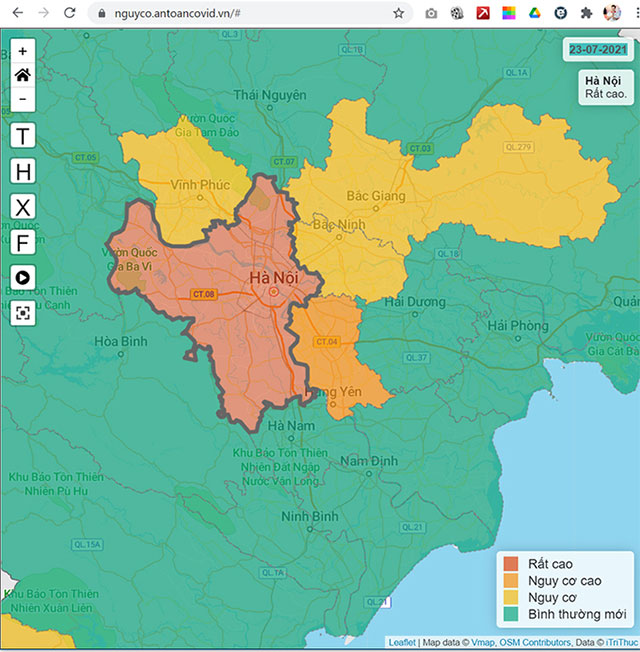What data makes Hanoi distance according to Directive 16?
On July 22, the Covid-19 risk warning map in Hanoi changed from yellow to red, and the next day, Deputy Prime Minister Vu Duc Dam discussed with Hanoi Chairman Chu Ngoc Anh.
The red color shows that the risk of the epidemic spreading in the capital is "Very High" - the highest level of the four warning levels given by the Rapid Response Information Team, National Steering Committee for Covid-19 Prevention and Control.
Mr. Nguyen The Trung, a member of the Rapid Response Information Team, said that data on July 22 showed that the two infection chains at Tam Duc Pharmacy (Lang Ha) and the group of people who tested themselves were growing larger, difficult to control, and at risk of spreading to over 50% of districts.
Based on experience gained through the epidemic prevention process, the Information Team believes that when the number of new F0 cases in 14 days exceeds 1/100,000 people, it is a risk, and Hanoi has now reached a rate of 4.43/100,000 people - an alarming level. Analysis of data by district also shows that there are 7 "High-risk" districts and 20/30 districts are in the "Risk" category.
Based on this data, the Team immediately reported to the Head of the National Steering Committee, Deputy Prime Minister Vu Duc Dam (who was working in Ho Chi Minh City at that time) and the Head of the Hanoi Steering Committee, Chairman Chu Ngoc Anh. The warning data was quite consistent with the assessment of the epidemic situation of the Hanoi Covid-19 Prevention and Control Steering Committee, when on July 22 and 23, the area recorded the highest increase in the number of positive cases since the beginning of the fourth wave of the epidemic. "After that, I learned that by the end of the morning of July 23, Deputy Prime Minister Vu Duc Dam had texted and called the City leaders to work, agreeing to apply Directive 16 in Hanoi as soon as possible ," said Mr. Trung.
After working and discussing many preparation plans, the agencies reached a consensus on the decision to apply social distancing throughout the city according to Directive 16 on the night of July 23.

Very High risk warning map in Hanoi on July 23. People can look up the risk map at nguyco.antoancovid.vn .
The Covid Safety Risk Map was built more than a year ago, with the analysis center located at the Government Office. The map provides four levels of epidemic warning: New normal (green); Risk (yellow); High risk (orange); Very high (red). The team will send daily reports to the National Steering Committee for Covid-19 Prevention and Control and localities, forecasting risks to the commune level.
Warning levels are based on data analysis of outbreaks, the relationship between outbreaks, the structure of disease contact groups, the severity of patients' symptoms. The team uses mathematical and statistical epidemiological models, machine learning, knowledge networks, and expert knowledge to answer questions: what is the risk of an area, where are important outbreaks, how will they develop further, where are potential super-spreading locations, and what is the local response capacity.
The team also received assessments from experts in epidemiology, sociology, mathematics, and information technology from leading institutes and schools such as the National Institute of Hygiene and Epidemiology, Hanoi Medical University, Vietnam National University, Hanoi and Ho Chi Minh City, Hanoi University of Science and Technology, University of Water Resources, Institute of Advanced Mathematics, etc.
"Data analysis is done in many ways for cross-evaluation, to answer in the most practical but theoretical way ," said Mr. Trung.
According to Mr. Trung, there are times when the Information Team has to face more specific questions such as: why choose 19 provinces instead of 22 or 24 provinces to apply Directive 16? Is it possible to grasp and control the outbreak in an area? Which commune, ward, or cluster of houses is at high risk?.
"Usually after collecting data, we have a night to analyze and make a report, but in urgent situations, we only have 1 hour, even 15 minutes to answer questions ," said Mr. Trung.

Mr. Nguyen The Trung (second from left) and a team of experts in the Rapid Response Information Team are analyzing data on May 22. (Photo: NVCC).
The rapid response team currently has 300 scientists, experts, and volunteers in epidemiology and information technology. "Through our experience in fighting the epidemic, we believe more and more in the interdisciplinary theory of using data to help with operations ," said Mr. Trung.
- Search for 'push' for IT to 'take off'
- NASA uses lasers to transmit data to a moon satellite
- New world record for wireless data transmission
- Utilities to help protect data
- New signal processing techniques can double the data transmission distance on fiber optic systems
- New Year of Hanoi makes people feel excited
- Video: A rare film about Hanoi street 50 years ago
- NASA sets a record for transmitting data over 225 million km
- Laser data transmission technology makes internet speed 1,000 times faster
- Recover data after incidents with Disaster Recovery
- Measure the distance between stars
- Successful data transfer by laboratory teleport technology
 March 2012: Launching H5N1 vaccine for poultry
March 2012: Launching H5N1 vaccine for poultry Experts comment on the mysterious gradual disappearance of the Delta variant in Japan
Experts comment on the mysterious gradual disappearance of the Delta variant in Japan Danger of the two Delta . branch variants
Danger of the two Delta . branch variants 2020 pandemic flu attack humans?
2020 pandemic flu attack humans?